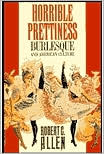
Horrible Prettiness: Burlesque and American Culture (1991)
By Robert C. Allen
Synopsis: Asks how burlesque moved from a movement of bold female transgression to one of mere spectacle. This book traces the history of burlesque in the U.S. via a history of theatre in the 1820s-30s, the wild chaos of the "lower class" crowds with their participatory nature, to the bourgeois-ification of burlesque in the 1850-60s, to the relegation of burlesque back to the working classes 1880-1920s, to its last-ditch efforts by taking over failed legit theatres in Times Square which only brought it increased public scrutiny and the moral outrage that led to its demise in the 1930s. Burlesque is complicated and complex, and its "decline" into pure female sexual spectacle at the end partly silenced the transgressive nature it had earlier when female performers actually talked and joked too. In those days, burlesque was largely about the bottom-up inversion of social order, with a focus on the grotesque and on the mockery of the power system in place.
Interesting Specifics:
Burlesque in the U.S. was tied to the "spectacular female performer" and raised "questions about how a woman should be 'allowed' to act on state, about how femininity should and could be represented, and about the relationship of women on stage to women in the outside, 'real' world" (21).
Burlesque as monstrous, grounded in the "aesthetics of transgression, inversion, and the grotesque" (26) - in "the low other."
Ordination = "the exercise of power bound by the limits of discourse;" Insubordination = "resistance contained by discourse" (35).
Argues that struggles over burlesque are about ordination and insubordination rather than domination and resistance (35).
In the late 18th-early 19-century there were many anti-theatrical laws because theatricality was said to "disrupt" the natural order of things; that to disguise oneself and act as something else was seen as mocking nature and God's order of things (47).
The third tier of the theatre was always reserved for prostitutes and their clients.
1820s-30s, theatre gets popular in the U.S.; 1850s marked huge shift in theatre - it became increasingly "feminized" and respectable and less rowdy.
Lydia Thompson Troupe huge.
Dyed blonde hair very popular, and became popular with middle class by 1860s.
Burlesque paralleled and/or joined minstrelsy a bit in the 1870s.
Vaudeville combined most of the other show types one one stage and was appealing to the middle class (tried not to offend); 1890s. Became first place women really attended alone.
Benjamin Franklin Keith largely responsible for creating this brand of clean, family-friendly egalitarian vaudeville, and vaudeville banned any kind of humor that relied on difference (i.e. that caricatured or drew attention to otherness in any way - was the opposite of burlesque).
Burlesque was mostly an East Coast, Midwest, and San Francisco urban phenomenon.
Burlesque posters depicted huge, all-powerful women "playing" wealthy men (i.e. "gold-diggers" riding huge lobsters in mockery of the fancy lobster palaces of the day). This prob didn't offend its mostly working-class audience because the men being lampooned were wealthy men.
Cooch dance merges in 1890s (with the Chicago Expo), a direct precursor to striptease. Runways were invented in 1917, and stripping didn't become standard part until 1920s.
By the 1890s, female burlesque dancers were silent on stage, and was now just about the sexual display of their bodies.
Depression of the 1930s caused many "legit" theatres to close, allowing burlesque to move into those spaces. This however hastened its demise as those in power didn't like them and sought to shut them down.
Interacts With:
Bakhtin; Manliness and Civilization; Houdini, Tarzan, and the Perfect Man;

No comments:
Post a Comment